David and Maureen Irwin recall the people and places that made Groomsport special when they first arrived in 1966.
David and Maureen Irwin remember the Manse that was their Groomsport home from 1966-1991. They recall good times–and a big bonfire.
Maureen Irwin shares her first memory of life on The Hill. She was daring and outgoing even in the early 1940s!
The village of Groomsport was first mapped by Thomas Raven in 1625, showing a number of houses near the harbour. Several important buildings were built in the 19th century. These included the Watch House (1821), the Parish church (1842), the Presbyterian church (1843), the first National School (1845), Groomsport House (1848) and the Lifeboat House (1858). In the latter half of the 20th century the village expanded with the building of the Springwell estate and other developments. In the early 21st century, the Cove Bay development added about 150 houses and the village now has about 750 dwellings.
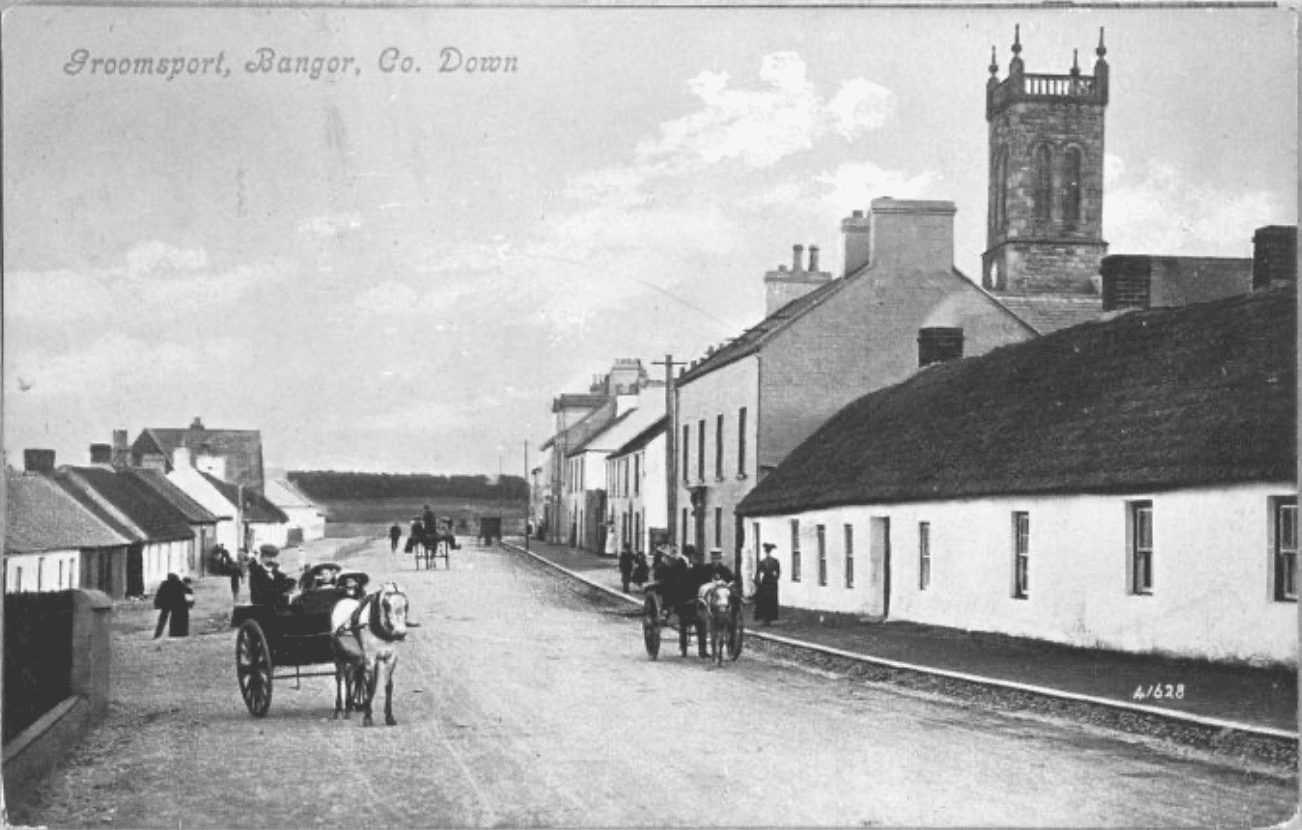


This website uses cookies to improve your experience. We\'ll assume you\'re ok with this, but you can opt-out if you wish. Read More

Sir James Hamilton commissioned Thomas Raven to map the lands he had acquired in 1604. The map shows that Groomsport was being used as a port 400 years ago. It shows boats in the harbour and a number of houses in the village.
0016 North Down Museum. Copyright Ards and North Down Council. Reproduced with permission.


The public house, on the left, this side of the Maxwell Hall, is a single storey building. It was replaced by a two-storey building in 1906. It is therefore likely that this photograph was taken in 1905. (In the St Andrews collection it is dated as 1903).
0017 Valentine Postcard. Copyright status unknown. Image courtesy of the University of St Andrews Library, ID JV-41628.
If you have more information about this photo, please contact discovergroomsport@gmail.com, citing the title above.

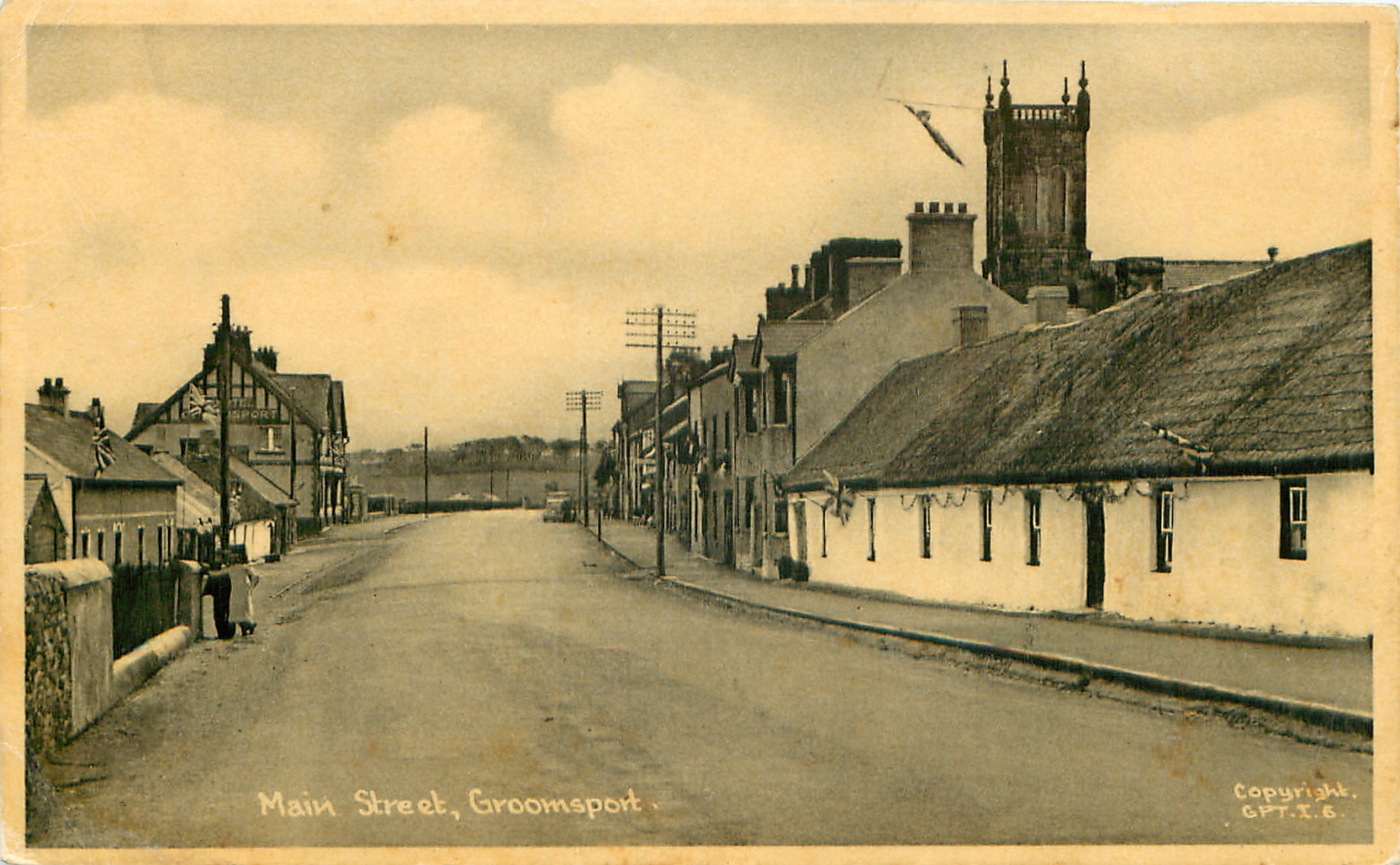
This view of Main Street probably dates from the middle of the 20th century as a motor car and telegraph poles can be seen. The display of flags suggests that the photograph was taken in July. The people on the left of the picture are standing at the top of the lane which led to the Cockle Row cottages.The building on the extreme left of the image was the Rocket House. This housed a Board of Trade horse-drawn carriage which contained lifesaving equipment for the rescue of those in danger in the sea after shipwrecks etc.
0018 Photograph by Raphael Tuck Postcards. Downloaded, with permission, from: https://www.tuckdbpostcards.org/items/128505-main-street


When the second National School (1895 to 1962) was replaced by the Primary School on Springwell Drive the building became the Presbyterian Church’s hall and was named after the Rev Walter Nelson. Although it has been extended several times, the original rectangular school building is at the heart of the hall.
Find out more about the Walter Nelson Hall and the National Schools at: https://discovergroomsport.com/wp-content/uploads/2023/02/National-Schools-v1a.pdf
0021 Copyright: Dan Parsons. https://www.parsonsart.co.uk


Groomsport House was built in 1848 by John Waring Maxwell for his nephew and heir, Robert Perceval-Maxwell. Designed in the “Jacobethan'”style by James Sands, it cost £6,000 to build using sandstone from Ayrshire. It was converted into apartments at the start of the 21st century.
Find out more about Groomsport House at: https://discovergroomsport.com/wp-content/uploads/2023/02/Groomsport-House-v3.pdf
0022 Copyright: Dan Parsons. https://www.parsonsart.co.uk


The Lodge was built in 1865, opposite the Parish Church, to accommodate the first rector of Groomsport. After he left the village in 1880, the Lodge was the home of Mrs Selina Perceval-Maxwell the widow of Robert Perceval-Maxwell’s eldest son, John. After her death in 1928 the Perceval-Maxwell family sold the Lodge.
0024 Copyright: Dan Parsons. https://www.parsonsart.co.uk


Gavin Perceval-Maxwell developed this caravan site in the grounds of Groomsport House. The Cove Bay development, which commenced in 2000, replaced the caravan site.
0020 Valentine Postcard. Copyright status unknown. Image courtesy of the University of St Andrews Library, ID JV-R-6329.


Groomsport House was built c.1848. In was the principal residence of Robert Perceval-Maxwell and his family form then until he succeeded his uncle, John Waring Maxwell, in 1869 when he moved to live at Finnebrogue, near Downpatrick.
This image appears to be identical to the image of Groomsport House in the Groomsport’s Masonic Lodge’s illuminated address to the Misses Perceval-Maxwell in 1911, thanking them for use of the Maxwell Hall.
0047 Hurst and Co. Fine Art Warehouse. Real Photo Series. North Down Museum.
Copyright: Ards and North Down Borough Council
Find out more about Groomsport House at:
https://discovergroomsport.com/wp-content/uploads/2023/02/Groomsport-House-v3.pdf


The car and charabanc are travelling from Groomsport towards Bangor on what was then the main road.
0050 North Down Museum. Copyright: Ards and North Down Borough Council.


The shelters replaced the cottages that had been demolished on Main Street, opposite the Presbyterian Church. This area, which runs down to the harbour, had previously been the back gardens of the cottages. The shelters and boundary walls were removed in later renovations of the area.
0132 Photograph supplied by Rev Dr David Irwin and Mrs Maureen Irwin


Beer barrels are being delivered to the pub by a cart pulled by draught horses. In the background, the last of the cottages on Main Street are being demolished.
0133 Photograph supplied by Rev Dr David Irwin and Mrs Maureen Irwin


This event was held to raise funds for the extension of the Presbyterian Church and was the precursor of many similar events on the Holme Field – Groomsport’s village green.
0139 Photograph supplied by Rev Dr David Irwin and Mrs Maureen Irwin


0141 Photograph supplied by Rev Dr David Irwin and Mrs Maureen Irwin
If you have more information about this photo please contact discovergroomsport@gmail.com mentioning the four digit number above.


A dramatisation of the voyage of Eagle Wing, which left Groomsport on 9th September 1636 was part of this pageant. Standing in the bow of the ship from left to right are: unknown, Mary Holland, Maureen Irwin and Margaret McCready.
0154 Photograph supplied by Rev Dr David Irwin and Mrs Maureen Irwin
If you have more information about this photo please contact discovergroomsport@gmail.com mentioning the four digit number above.

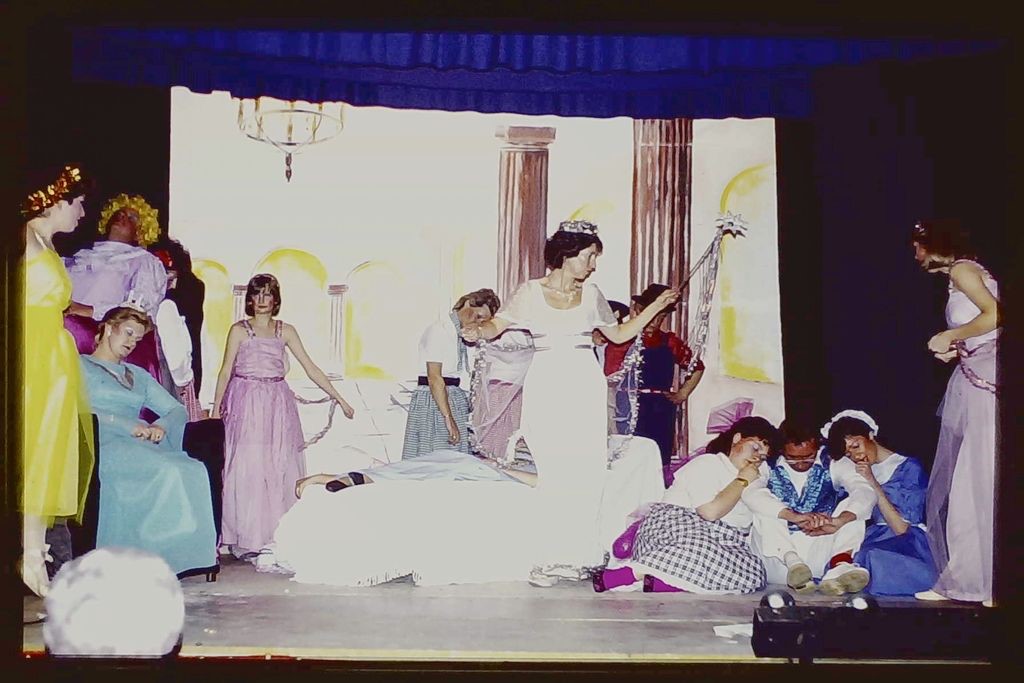
In this Turnstones Drama Group production, Maureen Irwin is centre stage in the role of the Good Fairy.
0155 Photograph supplied by Rev Dr David Irwin and Mrs Maureen Irwin
If you have more information about this photo please contact discovergroomsport@gmail.com mentioning the four digit number above.


In this Turnstones Drama group production, Rev Dr David Irwin is playing the Baron and Eric Cairns is the Dame.
0156 Photograph supplied by Rev Dr David Irwin and Mrs Maureen Irwin
If you have more information about this photo please contact discovergroomsport@gmail.com mentioning the four digit number above.


The final curtain call.
0157 Photograph supplied by Rev Dr David Irwin and Mrs Maureen Irwin
If you have more information about this photo please contact discovergroomsport@gmail.com mentioning the four digit number above.


Rev Dr David and Maureen Irwin perform a mime to “Who wants to be a millionaire?”
0158 Photograph supplied by Rev Dr David Irwin and Mrs Maureen Irwin


Rev Dr David and Maureen Irwin are cheered off stage.
0159 Photograph supplied by Rev Dr David Irwin and Mrs Maureen Irwin
If you have more information about this photo please contact discovergroomsport@gmail.com mentioning the four digit number above.

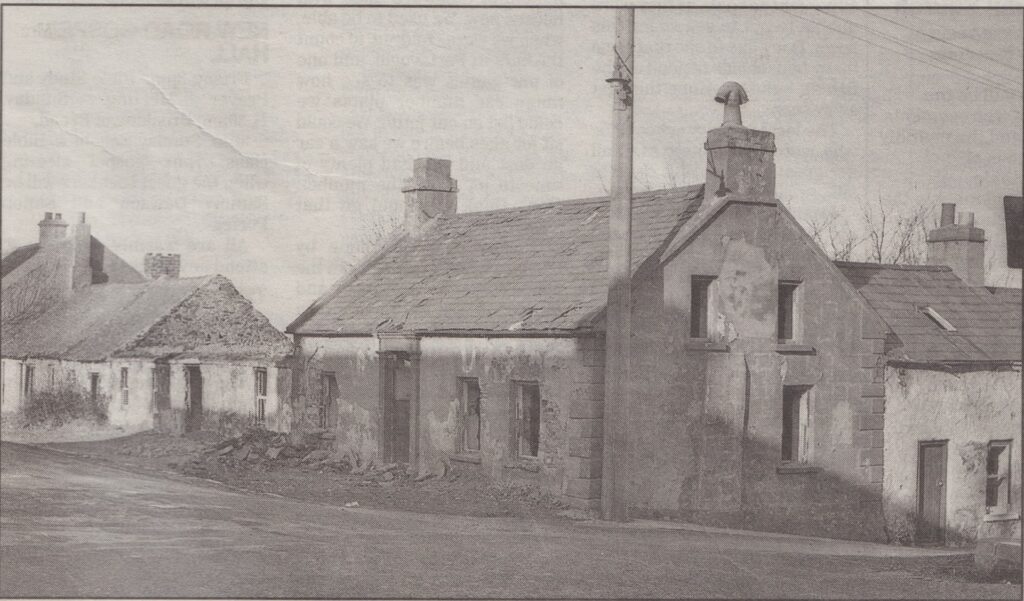
Quay Road is now known as Harbour Road.
0202 Photograph supplied by Julie Crawford
If you have more information about this photo please contact discovergroomsport@gmail.com mentioning the four digit number above.


John (Jack) Watterson made this payment to Gawn Perceval-Maxwell for 11 Main Street (now number 23) on the corner of The Hill.
0226 Supplied by Maurice Watterson


This house, which was built c.1870 was known as “Glass’s House”. It was said to be one of the most architecturally attractive houses in the village. It was demolished, after a period of dereliction, and replaced by a modern house in 1998.
The house on the left of the photograph was also demolished. The Briggs apartments were built on its site.
0267 Photograph supplied by Perry Moore.
If you have more information about this photo please contact discovergroomsport@gmail.com mentioning the four digit number above.

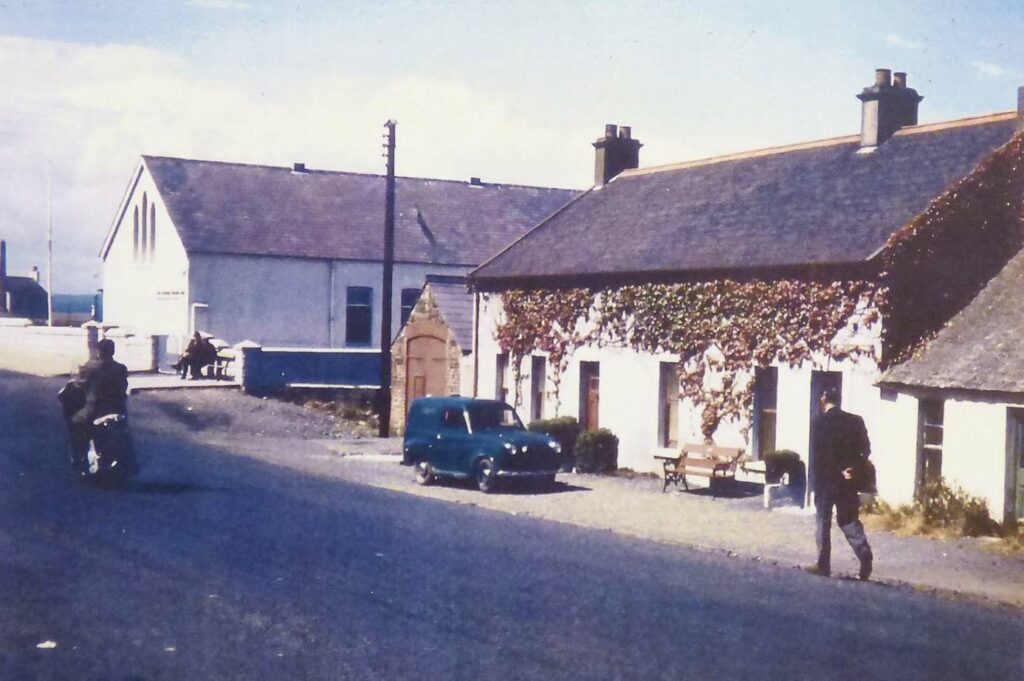
The building between Brae Cottage and the Walter Nelson Hall, had been the “Rocket House” or “Apparatus House” which had contained the Coastguard’s lifesaving equipment such as breeches buoys. In 1948 it had been purchased, at auction, by Mr John Stewart of Brae Cottage for £400.
0256 Photograph supplied by Perry Moore.
If you have more information about this photo please contact discovergroomsport@gmail.com mentioning the four digit number above.


The Arcadia Tea Rooms were above the shop.
This postcard was produced by Allen D Coon, an American photographer who worked in Ireland from 1902 until his death in 1938. This was one of a number of postcards that were printed exclusively for sale by Ellis.
0242 Photograph supplied by Groomsport Parish Archive
If you have more information about this photo please contact discovergroomsport@gmail.com mentioning the four digit number above.


These premises are currently used as a hairdressing salon.
0243 Photograph supplied by Perry Moore
If you have more information about this photo please contact discovergroomsport@gmail.com mentioning the four digit number above.


0266 Photograph supplied by Perry Moore.
If you have more information about this photo please contact discovergroomsport@gmail.com mentioning the four digit number above.


This is a photograph of the bus that served Groomsport form Bangor, via Ballyholme.
0240 Photograph supplied by Perry Moore.
If you have more information about this photo please contact discovergroomsport@gmail.com mentioning the four digit number above.

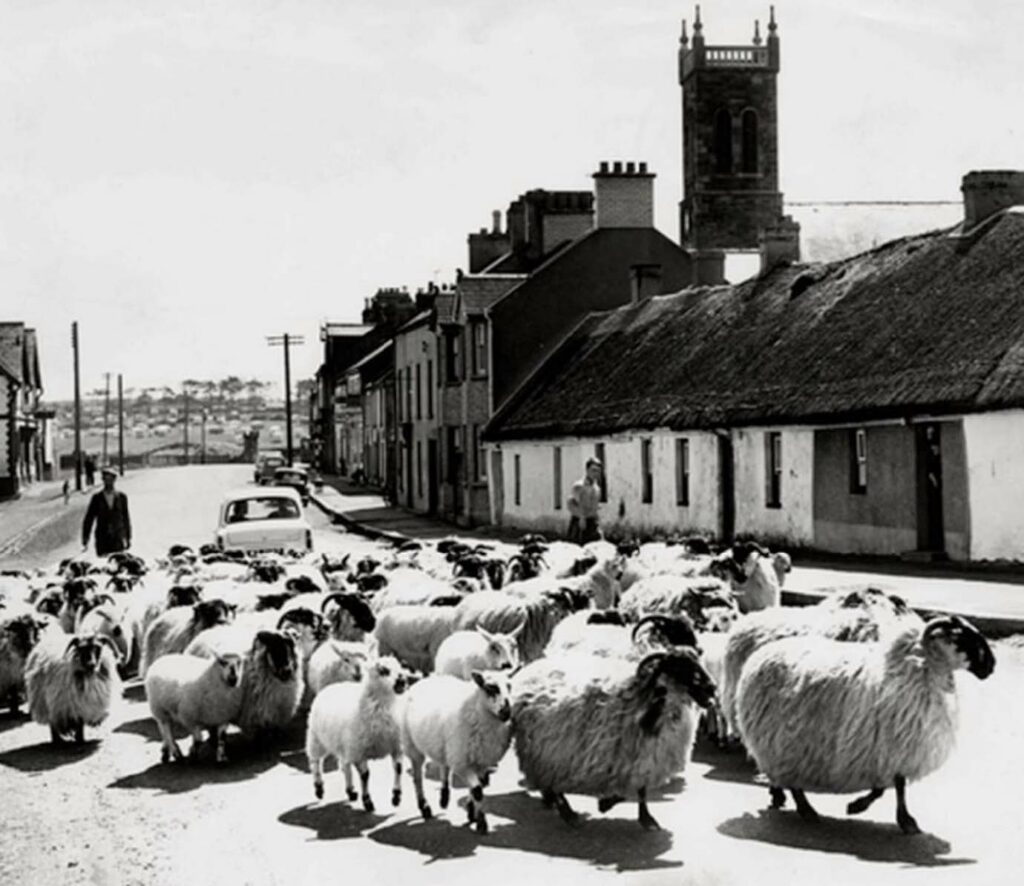
This photograph is labelled “Alec Martin from Moor Farm”.
0262 Photograph supplied by Perry Moore.
If you have more information about this photo please contact discovergroomsport@gmail.com mentioning the four digit number above.

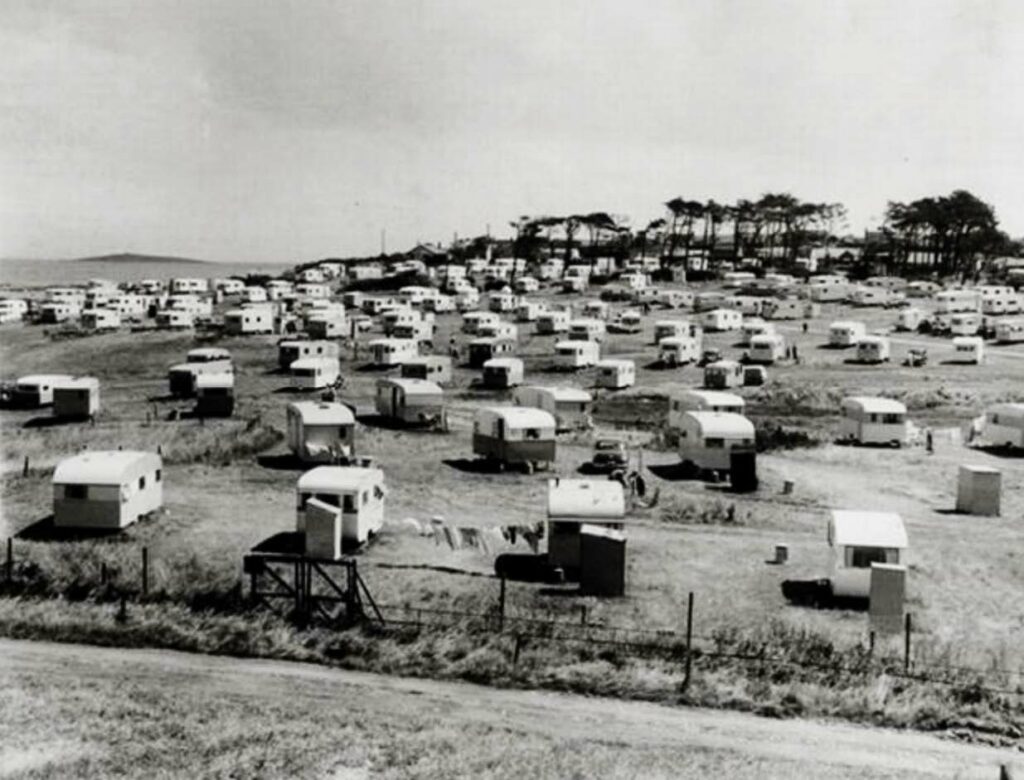
This caravan site was in the grounds of Groomsport House. In 2000 the caravans were replaced by the houses of the Cove Bay development.
0263 Photograph supplied by Perry Moore.
If you have more information about this photo please contact discovergroomsport@gmail.com mentioning the four digit number above.


This photograph shows the wide back street between the houses of The Hill (on the left) and their back gardens.
0257 Photograph supplied by Perry Moore.
If you have more information about this photo please contact discovergroomsport@gmail.com mentioning the four digit number above.


This is a photograph of the cottage before it was demolished and replaced in the 1960s.
0283 Photograph supplied by Margaret Parr.
If you have more information about this photo please contact discovergroomsport@gmail.com mentioning the four digit number above.


This is a photograph of rebuilding of house.
0284 Photograph supplied by Margaret Parr


Roy McWhinney (chair of Groomsport in Bloom) and his son, Ellis, are taking a break from preparing the entrance to the village at Islet Hill farm for planting.
The old “Springwell, 1997” sign was replaced with the current Ulster in Bloom sign, which also has the name of the village, in June 2016.
0294 Photograph supplied by Peter Gibson


The Groomsport Village Association established the Groomsport in Bloom committee in May 2025. That year, the main work undertaken was to clear the village of weeds. Along with the Council’s planting, that was enough for the village to be awarded second place in the Large Village section of Ulster in Bloom. The addition of planters and other new features in the village followed in later years.
The photograph shows a weeding party in July 2015 with the results of their labours in the large paper bags.
Standing, from the left: Doris Hutchison, Roy McWhinney (chair of Groomsport in Bloom), Miriam Gibson, Robert Cummings, Merab Opie, Mandy Ritchie, Victor Crawford, Anne McCullough and Brian McBride.
Sitting, from the left: Ellis McWhinney, Owen Savage and Rachel Cummings.
0291 Photograph by Peter Gibson


Groomsport’s Bug Hotel was a join initiative by Groomsport in Bloom and the staff and young people at the Intensive Support Learning Unit (which is based in the old primary school building on Springwell Drive).
The photograph of staff and young people was taken when the Bug Hotel was installed. On the left, in a cap, is Geoff Nelson, the learning support assistant who oversaw the construction of the Bug Hotel.
0292 Photograph by Peter Gibson


The small community orchard at The Hill was a joint initiative of Groomsport in Bloom and the Northern Ireland Housing Executive (NIHE), which owns the patch of land. Five bare-root trees were planted in December 2016.
Pictured are (from left): Merab Opie, Tim Stapleton, John Crockard and Gary Hilliard (NIHE).
0293 Photograph by Peter Gibson
